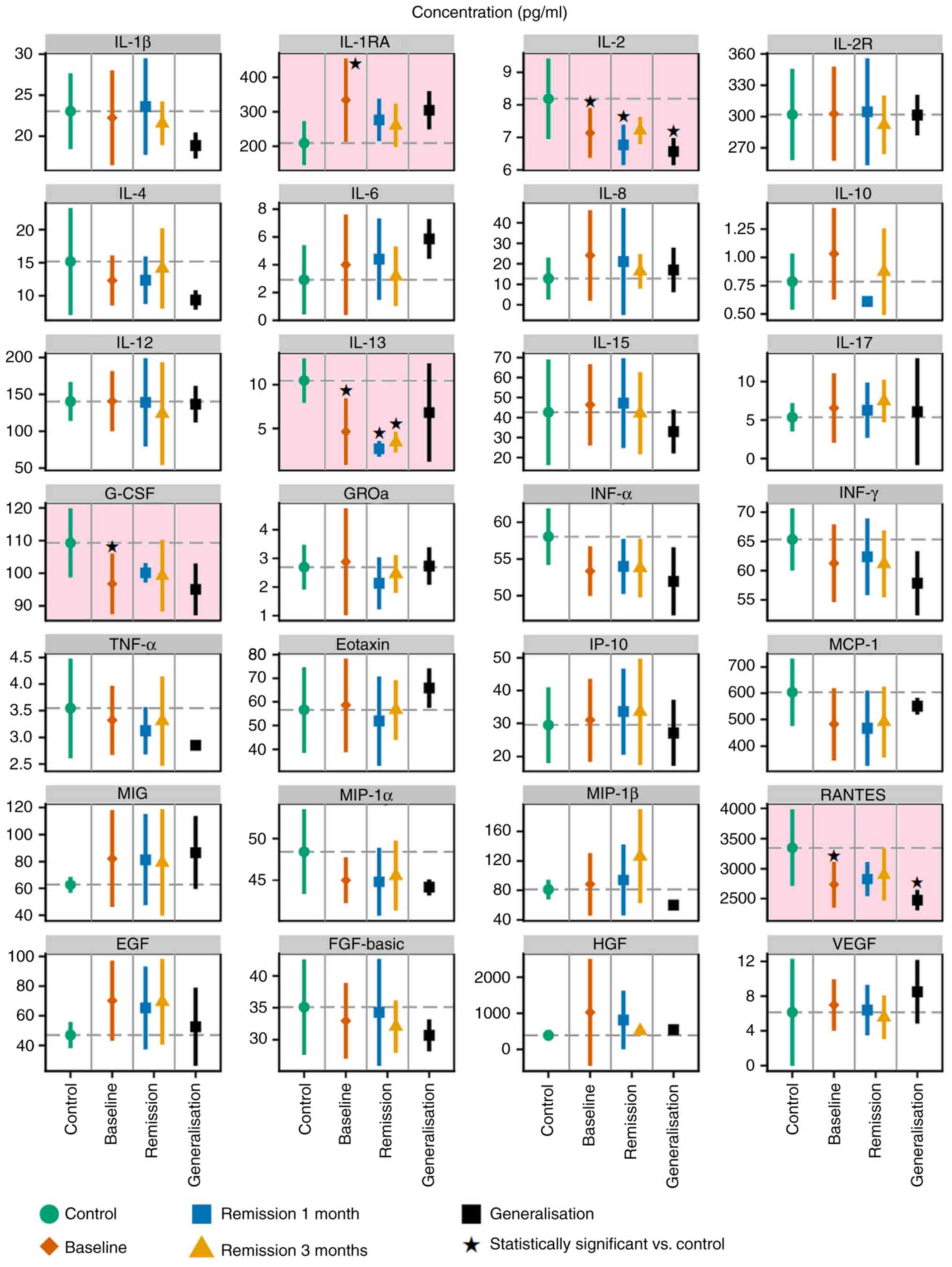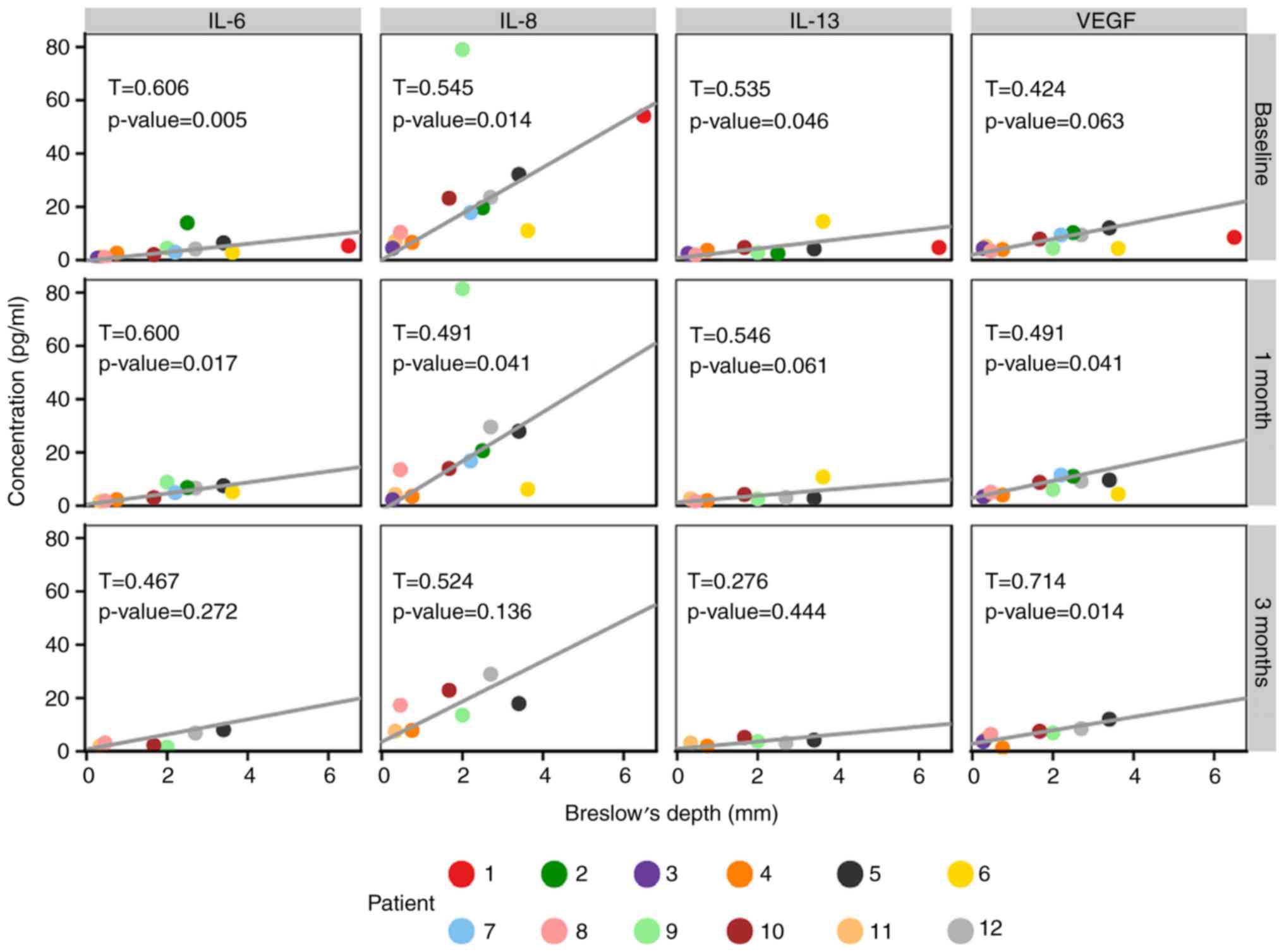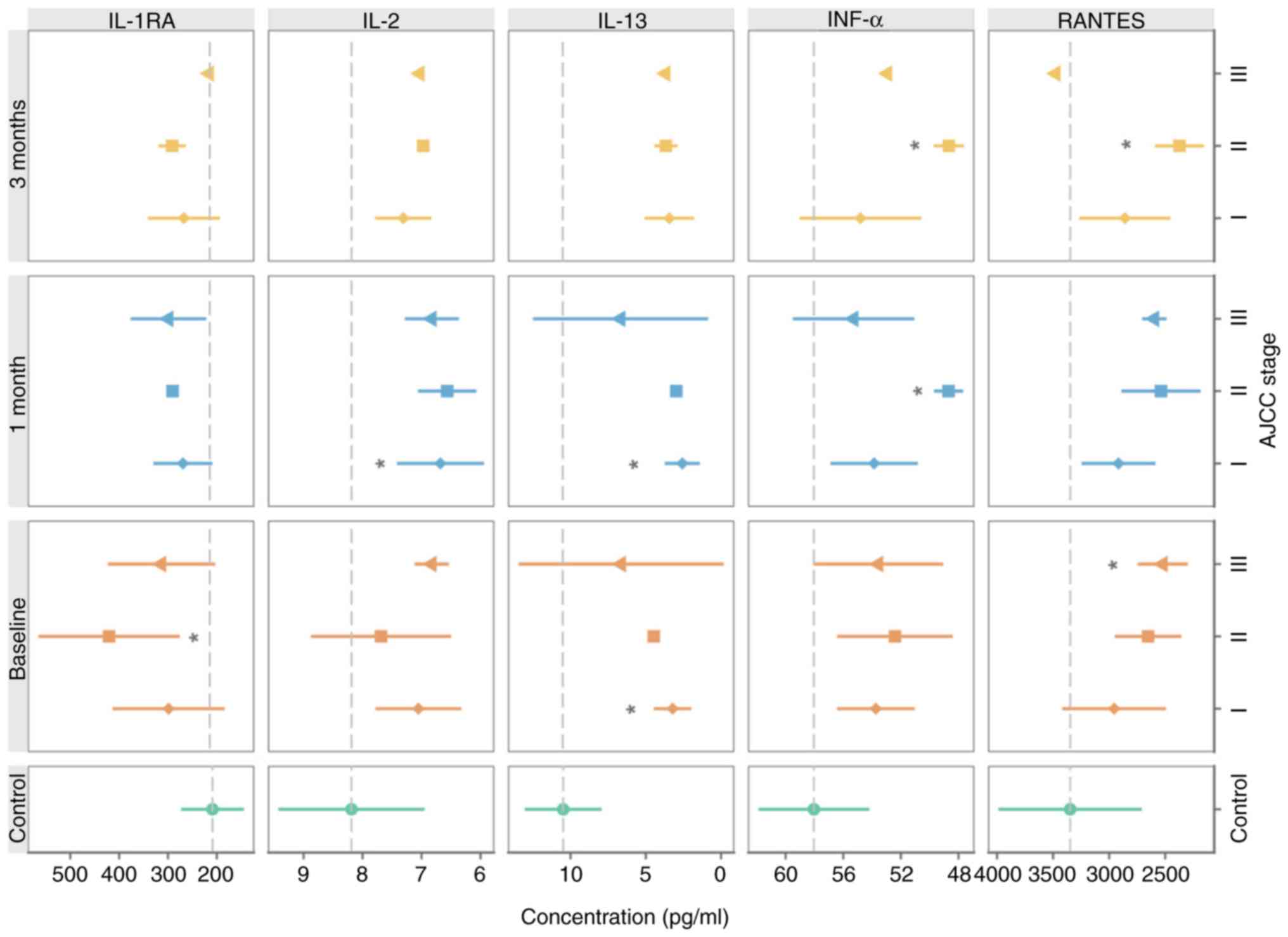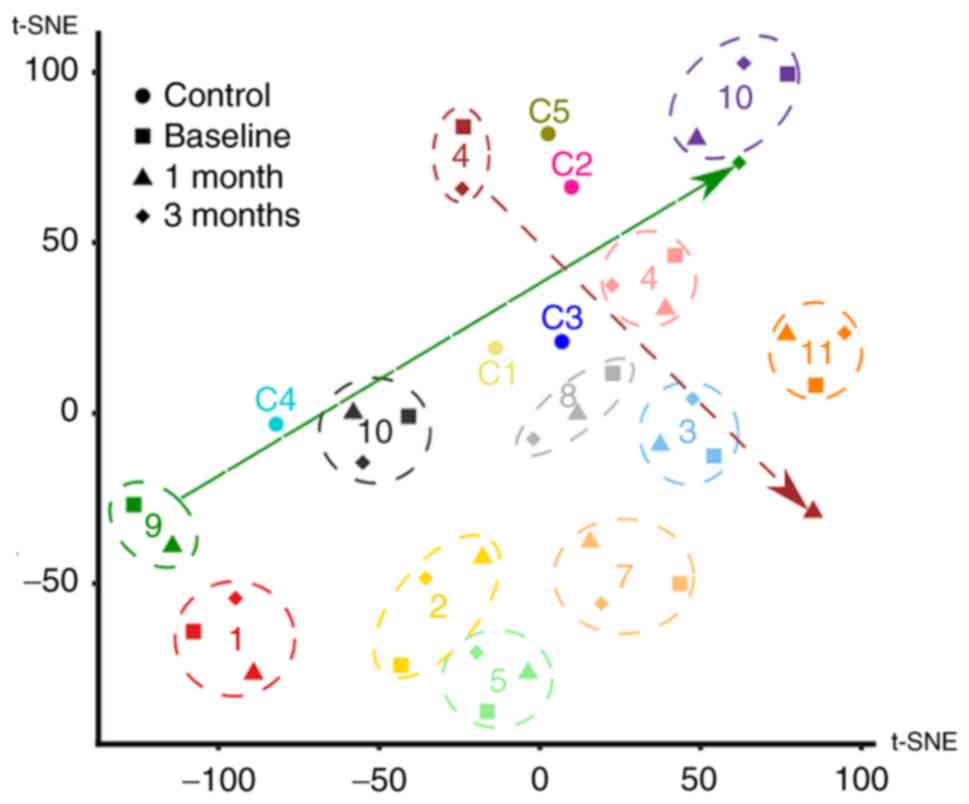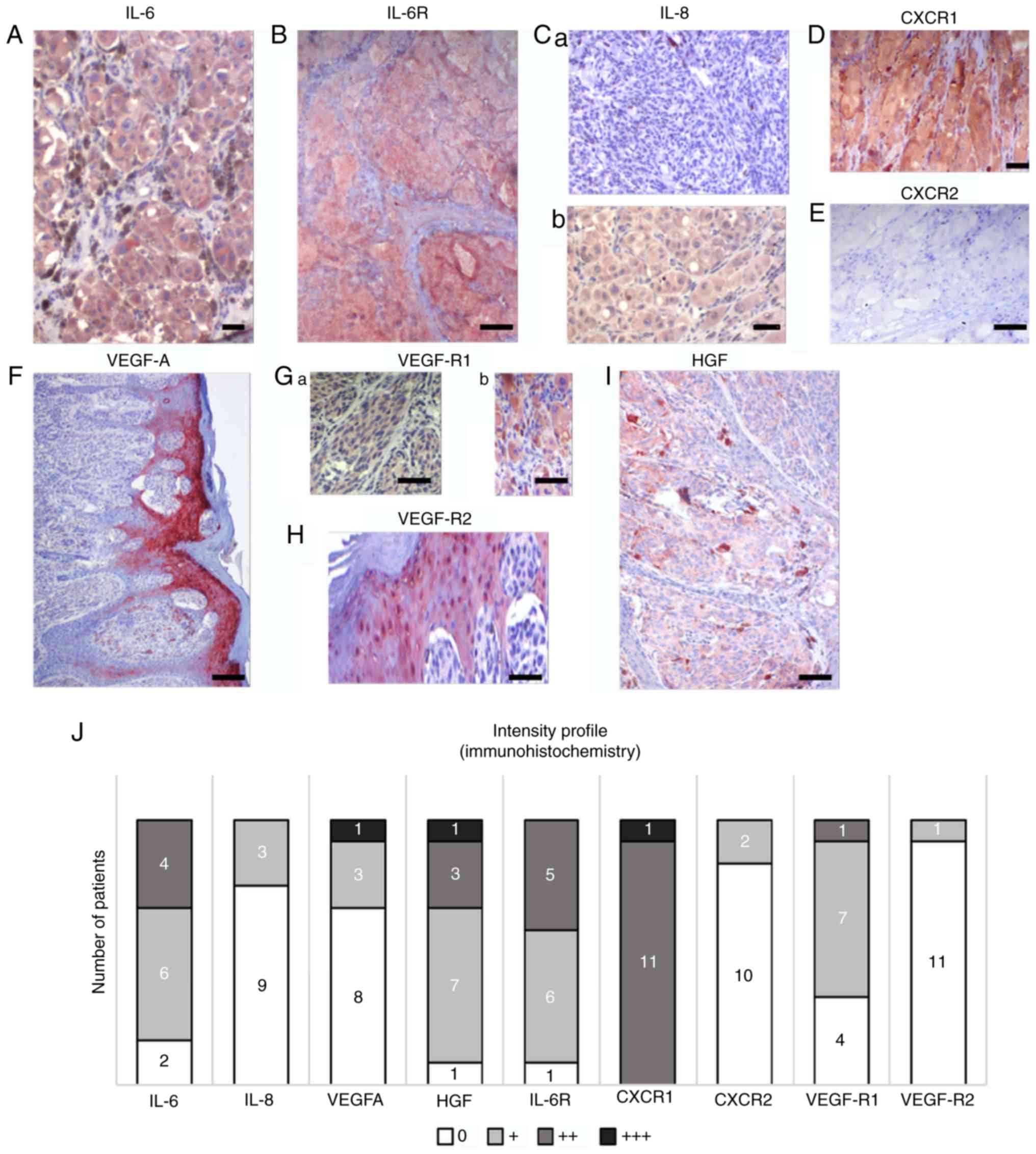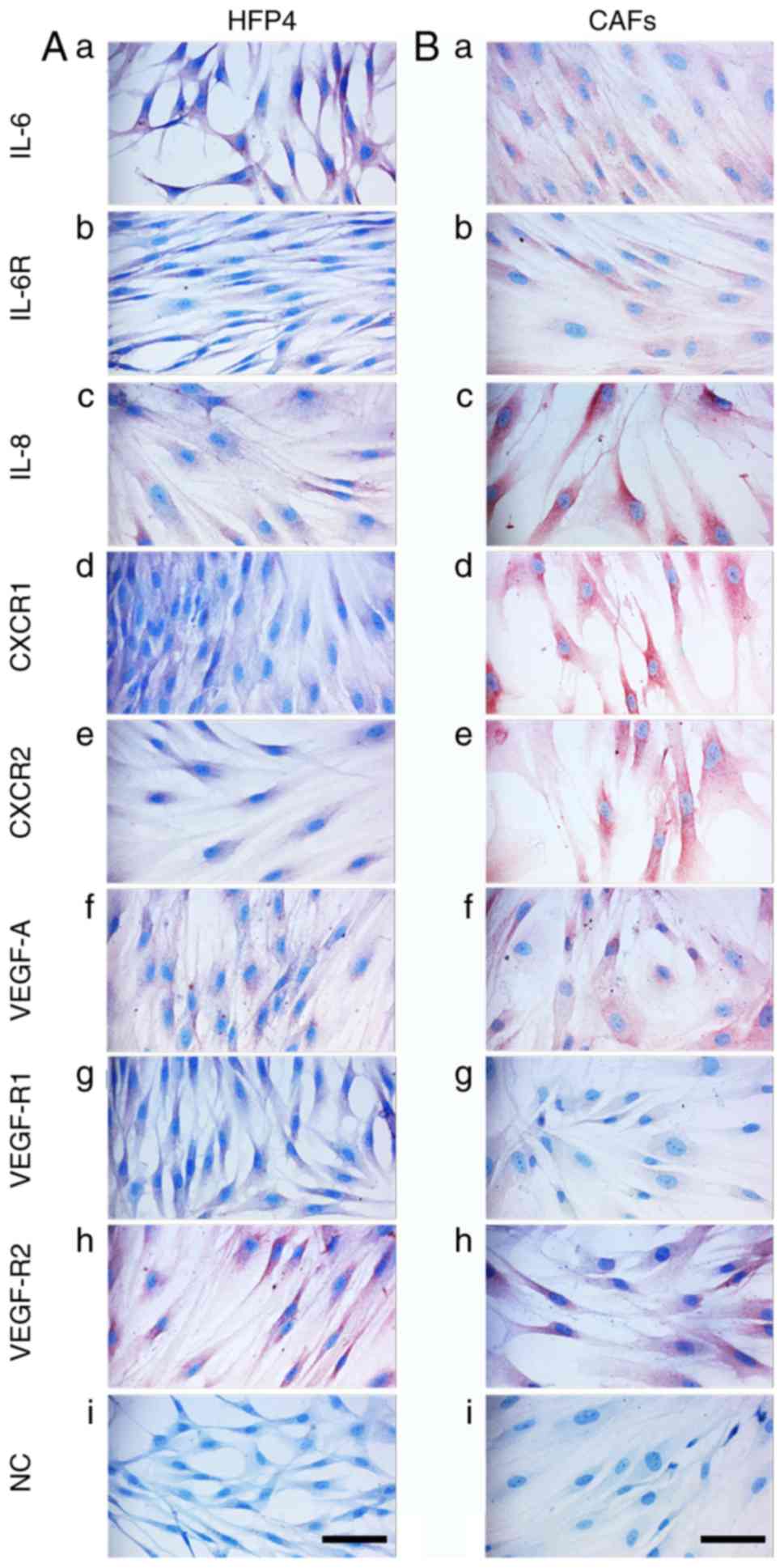|
1
|
Global Burden of Disease Cancer
Collaboration, ; Fitzmaurice C, Akinyemiju TF, Al Lami FH, Alam T,
Alizadeh-Navaei R, Allen C, Alsharif U, Alvis-Guzman N, Amini E, et
al: Global, regional, and national cancer incidence, mortality,
years of life lost, years lived with disability, and
disability-adjusted life-years for 29 cancer groups, 1990 to 2016:
A systematic analysis for the global burden of disease study. JAMA
Oncol. 4:1553–1568. 2018. View Article : Google Scholar : PubMed/NCBI
|
|
2
|
Schadendorf D, van Akkooi ACJ, Berking C,
Griewank KG, Gutzmer R, Hauschild A, Stang A, Roesch A and Ugurel
S: Melanoma. Lancet. 392:971–984. 2018. View Article : Google Scholar : PubMed/NCBI
|
|
3
|
Verma V, Sprave T, Haque W, Simone CB II,
Chang JY, Welsh JW and Thomas CR Jr: A systematic review of the
cost and cost-effectiveness studies of immune checkpoint
inhibitors. J Immunother Cancer. 6:1282018. View Article : Google Scholar : PubMed/NCBI
|
|
4
|
Zhang M, Yang J, Hua W, Li Z, Xu Z and
Qian Q: Monitoring checkpoint inhibitors: Predictive biomarkers in
immunotherapy. Front Med. 13:32–44. 2019. View Article : Google Scholar : PubMed/NCBI
|
|
5
|
Breslow A: Thickness, cross-sectional
areas and depth of invasion in the prognosis of cutaneous melanoma.
Ann Surg. 172:902–908. 1970. View Article : Google Scholar : PubMed/NCBI
|
|
6
|
Gershenwald JE, Scolyer RA, Hess KR,
Sondak VK, Long GV, Ross MI, Lazar AJ, Faries MB, Kirkwood JM,
McArthur GA, et al: Melanoma staging: Evidence-based changes in the
American Joint Committee on Cancer eighth edition cancer staging
manual. CA Cancer J Clin. 67:472–492. 2017. View Article : Google Scholar : PubMed/NCBI
|
|
7
|
Amann VC, Ramelyte E, Thurneysen S,
Pitocco R, Bentele-Jaberg N, Goldinger SM, Dummer R and Mangana J:
Developments in targeted therapy in melanoma. Eur J Surg Oncol.
43:581–593. 2017. View Article : Google Scholar : PubMed/NCBI
|
|
8
|
Karagiannis P, Fittall M and Karagiannis
SN: Evaluating biomarkers in melanoma. Front Oncol.
4:3832015.PubMed/NCBI
|
|
9
|
Jurisic V, Radenkovic S and Konjevic G:
The actual role of LDH as tumor marker, biochemical and clinical
aspects. Adv Exp Med Biol. 867:115–124. 2015. View Article : Google Scholar : PubMed/NCBI
|
|
10
|
Gebhardt C, Lichtenberger R and Utikal J:
Biomarker value and pitfalls of serum S100B in the follow-up of
high-risk melanoma patients. J Dtsch Dermatol Ges. 14:158–164.
2016. View Article : Google Scholar : PubMed/NCBI
|
|
11
|
Dummer R, Hauschild A, Lindenblatt N,
Pentheroudakis G and Keilholz U; ESMO Guidelines Committee, :
Cutaneous melanoma: ESMO clinical practice guidelines for
diagnosis, treatment and follow-up. Ann Oncol. 26 (Suppl
5):v126–v132. 2015. View Article : Google Scholar : PubMed/NCBI
|
|
12
|
Dummer R, Siano M, Hunger R, Lindenblatt
N, Braun R, Michielin O, Mihic-Probst D, von Moos R, Najafi Y,
Guckenberger M and Arnold A: The updated Swiss guidelines 2016 for
the treatment and follow-up of cutaneous melanoma. Swiss Med Wkly.
146:142792016.
|
|
13
|
Pflugfelder A, Kochs C, Blum A, Capellaro
M, Czeschik C, Dettenborn T, Dill D, Dippel E, Eigentler T, Feyer
P, et al: Malignant melanoma S3-guideline ‘diagnosis, therapy and
follow-up of melanoma.’. J Dtsch Dermatol Ges. 11 (Suppl
6):S1–S126. 2013.(In English, German). View Article : Google Scholar
|
|
14
|
Paget S: The distribution of secondary
growths in cancer of the breast. Lancet. 1:571–573. 1889.
View Article : Google Scholar
|
|
15
|
Kareva I: What can ecology teach us about
cancer? Transl Oncol. 4:266–270. 2011. View Article : Google Scholar : PubMed/NCBI
|
|
16
|
Lacina L, Plzak J, Kodet O, Szabo P,
Chovanec M, Dvorankova B and Smetana K Jr: Cancer microenvironment:
What can we learn from the stem cell niche. Int J Mol Sci.
16:24094–24110. 2015. View Article : Google Scholar : PubMed/NCBI
|
|
17
|
Kodet O, Dvořánková B, Krejčí E, Szabo P,
Dvořák P, Štork J, Krajsová I, Dundr P, Smetana K Jr and Lacina L:
Cultivation-dependent plasticity of melanoma phenotype. Tumour
Biol. 34:3345–3355. 2013. View Article : Google Scholar : PubMed/NCBI
|
|
18
|
Kodet O, Dvořánková B, Bendlova B,
Sýkorová V, Krajsová I, Štork J, Kučera J, Szabo P, Strnad H, Kolář
M, et al: Microenvironment-driven resistance to B-Raf inhibition in
a melanoma patient is accompanied by broad changes of gene
methylation and expression in distal fibroblasts. Int J Mol Med.
41:2687–2703. 2018.PubMed/NCBI
|
|
19
|
Manzano JL, Layos L, Bugés C, de Los
Llanos Gil M, Vila L, Martínez-Balibrea E and Martínez-Cardús A:
Resistant mechanisms to BRAF inhibitors in melanoma. Ann Transl
Med. 4:2372016. View Article : Google Scholar : PubMed/NCBI
|
|
20
|
Li YC, Zou JM, Luo C, Shu Y, Luo J, Qin J,
Wang Y, Li D, Wang SS, Chi G, et al: Circulating tumor cells
promote the metastatic colonization of disseminated carcinoma cells
by inducing systemic inflammation. Oncotarget. 8:28418–28430.
2017.PubMed/NCBI
|
|
21
|
Brouwer A, De Laere B, Peeters D, Peeters
M, Salgado R, Dirix L and Van Laere S: Evaluation and consequences
of heterogeneity in the circulating tumor cell compartment.
Oncotarget. 7:48625–48643. 2016. View Article : Google Scholar : PubMed/NCBI
|
|
22
|
Mignogna C, Scali E, Camastra C, Presta I,
Zeppa P, Barni T, Donato G, Bottoni U and Di Vito A: Innate
immunity in cutaneous melanoma. Clin Exp Dermatol. 42:243–250.
2017. View Article : Google Scholar : PubMed/NCBI
|
|
23
|
Kodet O, Lacina L, Krejčí E, Dvořánková B,
Grim M, Štork J, Kodetová D, Vlček Č, Šáchová J, Kolář M, et al:
Melanoma cells influence the differentiation pattern of human
epidermal keratinocytes. Mol Cancer. 14:12015. View Article : Google Scholar : PubMed/NCBI
|
|
24
|
Lacina L, Smetana K Jr, Dvoránková B,
Pytlík R, Kideryová L, Kucerová L, Plzáková Z, Stork J, Gabius HJ
and André S: Stromal fibroblasts from basal cell carcinoma affect
phenotype of normal keratinocytes. Br J Dermatol. 156:819–829.
2007. View Article : Google Scholar : PubMed/NCBI
|
|
25
|
Jobe NP, Živicová V, Mifková A, Rösel D,
Dvořánková B, Kodet O, Strnad H, Kolář M, Šedo A, Smetana K Jr, et
al: Fibroblasts potentiate melanoma cells in vitro invasiveness
induced by UV-irradiated keratinocytes. Histochem Cell Biol.
149:503–516. 2018. View Article : Google Scholar : PubMed/NCBI
|
|
26
|
Dvořánková B, Lacina L and Smetana K Jr:
Isolation of normal fibroblasts and their cancer-associated
counterparts (CAFs) for biomedical research. Methods Mol Biol.
1879:393–406. 2019. View Article : Google Scholar : PubMed/NCBI
|
|
27
|
R Core Team R: A Language and Environment
for Statistical Computing. 2017, https://www.R-project.org/
|
|
28
|
Sanz H, Aponte JJ, Harezlak J, Dong Y,
Ayestaran A, Nhabomba A, Mpina M, Maurin OR, Díez-Padrisa N,
Aguilar R, et al: drLumi: An open-source package to manage data,
calibrate, and conduct quality control of multiplex bead-based
immunoassays data analysis. PLoS One. 12:e01879012017. View Article : Google Scholar : PubMed/NCBI
|
|
29
|
Colin B, Clifford S, Wu P, Rathmanner S
and Mengersen K: Using boosted regression trees and remotely sensed
data to drive decision-making. Open J Statistics. 7:859–875. 2017.
View Article : Google Scholar
|
|
30
|
Dunnett CW: A multiple comparison
procedure for comparing several treatments with a control. J Am
Stat Assoc. 50:1096–1121. 1955. View Article : Google Scholar
|
|
31
|
Porshneva K, Papiernik D, Psurski M,
Łupicka-Słowik A, Matkowski R, Ekiert M, Nowak M, Jarosz J, Banach
J, Milczarek M, et al: Temporal inhibition of mouse mammary gland
cancer metastasis by CORM-A1 and DETA/NO combination therapy.
Theranostics. 9:3918–3939. 2019. View Article : Google Scholar : PubMed/NCBI
|
|
32
|
Schou IM and Marschner IC: Design of
clinical trials involving multiple hypothesis tests with a common
control. Biom J. 59:636–657. 2017. View Article : Google Scholar : PubMed/NCBI
|
|
33
|
Rtsne: T-Distributed Stochastic Neighbor
Embedding using a Barnes-Hut Implementation. https://cran.r-project.org/web/packages/Rtsne/index.html
|
|
34
|
Muqaku B, Eisinger M, Meier SM, Tahir A,
Pukrop T, Haferkamp S, Slany A, Reichle A and Gerner C: Multi-omics
analysis of serum samples demonstrates reprogramming of organ
functions via systemic calcium mobilization and platelet activation
in metastatic melanoma. Mol Cell Proteomics. 16:86–99. 2017.
View Article : Google Scholar : PubMed/NCBI
|
|
35
|
Weber JS, Sznol M, Sullivan RJ, Blackmon
S, Boland G, Kluger HM, Halaban R, Bacchiocchi A, Ascierto PA,
Capone M, et al: A serum protein signature associated with outcome
after anti-PD-1 therapy in metastatic melanoma. Cancer Immunol Res.
6:79–86. 2018. View Article : Google Scholar : PubMed/NCBI
|
|
36
|
Ortiz A and Fuchs SY: Anti-metastatic
functions of type 1 interferons: Foundation for the adjuvant
therapy of cancer. Cytokine. 89:4–11. 2017. View Article : Google Scholar : PubMed/NCBI
|
|
37
|
Mizui M: Natural and modified IL-2 for the
treatment of cancer and autoimmune diseases. Clin Immunol. Nov
8–201.(Epub ahead of print). doi: 10.1016/j.clim.2018.11.002.
|
|
38
|
Arend WP: Interleukin 1 receptor
antagonist. A new member of the interleukin 1 family. J Clin
Invest. 88:1445–1451. 1991. View Article : Google Scholar : PubMed/NCBI
|
|
39
|
Ma HL, Whitters MJ, Jacobson BA, Donaldson
DD, Collins M and Dunussi-Joannopoulos K: Tumor cells secreting
IL-13 but not IL-13Ralpha2 fusion protein have reduced
tumorigenicity in vivo. Int Immunol. 16:1009–1017. 2004. View Article : Google Scholar : PubMed/NCBI
|
|
40
|
Lavi G, Voronov E, Dinarello CA, Apte RN
and Cohen S: Sustained delivery of IL-1 Ra from biodegradable
microspheres reduces the number of murine B16 melanoma lung
metastases. J Control Release. 123:123–130. 2007. View Article : Google Scholar : PubMed/NCBI
|
|
41
|
Alva A, Daniels GA, Wong MK, Kaufman HL,
Morse MA, McDermott DF, Clark JI, Agarwala SS, Miletello G, Logan
TF, et al: Contemporary experience with high-dose interleukin-2
therapy and impact on survival in patients with metastatic melanoma
and metastatic renal cell carcinoma. Cancer Immunol Immunother.
65:1533–1544. 2016. View Article : Google Scholar : PubMed/NCBI
|
|
42
|
Buchbinder EI, Gunturi A, Perritt J,
Dutcher J, Aung S, Kaufman HL, Ernstoff MS, Miletello GP, Curti BD,
Daniels GA, et al: A retrospective analysis of High-Dose
Interleukin-2 (HD IL-2) following Ipilimumab in metastatic
melanoma. J Immunother Cancer. 4:522016. View Article : Google Scholar : PubMed/NCBI
|
|
43
|
Cambien B, Richard-Fiardo P, Karimdjee BF,
Martini V, Ferrua B, Pitard B, Schmid-Antomarchi H and Schmid-
Alliana A: CCL5 neutralization restricts cancer growth and
potentiates the targeting of PDGFRβ in colorectal carcinoma. PLoS
One. 6:e288422011. View Article : Google Scholar : PubMed/NCBI
|
|
44
|
Aldinucci D and Colombatti A: The
inflammatory chemokine CCL5 and cancer progression. Mediators
Inflamm. 2014:2923762014. View Article : Google Scholar : PubMed/NCBI
|
|
45
|
Kolar M, Szabo P, Dvořánková B, Lacina L,
Gabius HJ, Strnad H, Sáchová J, Vlček C, Plzák J, Chovanec M, et
al: Upregulation of IL-6, IL-8 and CXCL-1 production in dermal
fibroblasts by normal/malignant epithelial cells in vitro:
Immunohistochemical and transcriptomic analyses. Biol Cell.
104:738–751. 2012. View Article : Google Scholar : PubMed/NCBI
|
|
46
|
Jobe NP, Rosel D, Dvořánková B, Kodet O,
Lacina L, Mateu R, Smetana K and Brábek J: Simultaneous blocking of
IL-6 and IL-8 is sufficient to fully inhibit CAF-induced human
melanoma cell invasiveness. Histochem Cell Biol. 146:205–217. 2016.
View Article : Google Scholar : PubMed/NCBI
|
|
47
|
Moretti S, Chiarugi A, Semplici F, Salvi
A, De Giorgi V, Fabbri P and Mazzoli S: Serum imbalance of
cytokines in melanoma patients. Melanoma Res. 11:395–399. 2001.
View Article : Google Scholar : PubMed/NCBI
|
|
48
|
Guida M, Riccobon A, Biasco G, Ravaioli A,
Casamassima A, Freschi A, Palma MD, Galligioni E, Nortilli R,
Chiarion-Sileni V, et al: Basal level and behaviour of cytokines in
a randomized outpatient trial comparing chemotherapy and
biochemotherapy in metastatic melanoma. Melanoma Res. 16:317–323.
2006. View Article : Google Scholar : PubMed/NCBI
|
|
49
|
Yurkovetsky ZR, Kirkwood JM, Edington HD,
Marrangoni AM, Velikokhatnaya L, Winans MT, Gorelik E and Lokshin
AE: Multiplex analysis of serum cytokines in melanoma patients
treated with interferon-alpha2b. Clin Cancer Res. 13:2422–2428.
2007. View Article : Google Scholar : PubMed/NCBI
|
|
50
|
Jiang H, Gebhardt C, Umansky L, Beckhove
P, Schulze TJ, Utikal J and Umansky V: Elevated chronic
inflammatory factors and myeloid-derived suppressor cells indicate
poor prognosis in advanced melanoma patients. Int J Cancer.
136:2352–2360. 2015. View Article : Google Scholar : PubMed/NCBI
|
|
51
|
Mocellin S, Zavagno G and Nitti D: The
prognostic value of serum S100B in patients with cutaneous
melanoma: A meta-analysis. Int J Cancer. 123:2370–2376. 2008.
View Article : Google Scholar : PubMed/NCBI
|
|
52
|
Jayatilaka H, Tyle P, Chen JJ, Kwak M, Ju
J, Kim HJ, Lee JSH, Wu PH, Gilkes DM, Fan R and Wirtz D:
Synergistic IL-6 and IL-8 paracrine signalling pathway infers a
strategy to inhibit tumour cell migration. Nat Commun. 8:155842017.
View Article : Google Scholar : PubMed/NCBI
|
|
53
|
Lu C and Kerbel RS: Interleukin-6
undergoes transition from paracrine growth inhibitor to autocrine
stimulator during human melanoma progression. J Cell Biol.
120:1281–1288. 1993. View Article : Google Scholar : PubMed/NCBI
|
|
54
|
Armstrong CA, Murray N, Kennedy M, Koppula
SV, Tara D and Ansel JC: Melanoma-derived interleukin 6 inhibits in
vivo melanoma growth. J Invest Dermatol. 102:278–284. 1994.
View Article : Google Scholar : PubMed/NCBI
|
|
55
|
Uemura M, Trinh VA, Haymaker C, Jackson N,
Kim DW, Allison JP, Sharma P, Vence L, Bernatchez C, Hwu P and Diab
A: Selective inhibition of autoimmune exacerbation while preserving
the anti-tumor clinical benefit using IL-6 blockade in a patient
with advanced melanoma and Crohn's disease: A case report. J
Hematol Oncol. 9:812016. View Article : Google Scholar : PubMed/NCBI
|
|
56
|
Narsale AA and Carson JA: Role of
interleukin-6 in cachexia: Therapeutic implications. Curr Opin
Support Palliat Care. 8:321–327. 2014. View Article : Google Scholar : PubMed/NCBI
|
|
57
|
Belizario JE, Fontes-Oliveira CC, Borges
JP, Kashiabara JA and Vannier E: Skeletal muscle wasting and
renewal: A pivotal role of myokine IL-6. Springerplus. 5:6192016.
View Article : Google Scholar : PubMed/NCBI
|
|
58
|
Miller A, McLeod L, Alhayyani S, Szczepny
A, Watkins DN, Chen W, Enriori P, Ferlin W, Ruwanpura S and Jenkins
BJ: Blockade of the IL-6 trans-signalling/STAT3 axis suppresses
cachexia in Kras-induced lung adenocarcinoma. Oncogene.
36:3059–3066. 2017. View Article : Google Scholar : PubMed/NCBI
|
|
59
|
Pettersen K, Andersen S, Degen S, Tadini
V, Grosjean J, Hatakeyama S, Tesfahun AN, Moestue S, Kim J, Nonstad
U, et al: Cancer cachexia associates with a systemic
autophagy-inducing activity mimicked by cancer cell-derived IL-6
trans-signaling. Sci Rep. 7:20462017. View Article : Google Scholar : PubMed/NCBI
|
|
60
|
Singh S, Singh AP, Sharma B, Owen LB and
Singh RK: CXCL8 and its cognate receptors in melanoma progression
and metastasis. Future Oncol. 6:111–116. 2010. View Article : Google Scholar : PubMed/NCBI
|
|
61
|
Sanmamed MF, Perez-Gracia JL, Schalper KA,
Fusco JP, Gonzalez A, Rodriguez-Ruiz ME, Oñate C, Perez G, Alfaro
C, Martín-Algarra S, et al: Changes in serum interleukin-8 (IL-8)
levels reflect and predict response to anti-PD-1 treatment in
melanoma and non-small-cell lung cancer patients. Ann Oncol.
28:1988–1995. 2017. View Article : Google Scholar : PubMed/NCBI
|
|
62
|
Gabellini C, Gómez-Abenza E, Ibáñez-Molero
S, Tupone MG, Pérez-Oliva AB, de Oliveira S, Del Bufalo D and
Mulero V: Interleukin 8 mediates bcl-xL-induced enhancement of
human melanoma cell dissemination and angiogenesis in a zebrafish
xenograft model. Int J Cancer. 142:584–596. 2018. View Article : Google Scholar : PubMed/NCBI
|
|
63
|
Sanmamed MF, Carranza-Rua O, Alfaro C,
Oñate C, Martín-Algarra S, Perez G, Landazuri SF, Gonzalez A, Gross
S, Rodriguez I, et al: Serum interleukin-8 reflects tumor burden
and treatment response across malignancies of multiple tissue
origins. Clin Cancer Res. 20:5697–5707. 2014. View Article : Google Scholar : PubMed/NCBI
|
|
64
|
Jayson GC, Kerbel R, Ellis LM and Harris
AL: Antiangiogenic therapy in oncology: Current status and future
directions. Lancet. 388:518–529. 2016. View Article : Google Scholar : PubMed/NCBI
|
|
65
|
Nevala WK, Vachon CM, Leontovich AA, Scott
CG, Thompson MA and Markovic SN; Melanoma Study Group of the Mayo
Clinic Cancer Center, : Evidence of systemic Th2-driven chronic
inflammation in patients with metastatic melanoma. Clin Cancer Res.
15:1931–1939. 2009. View Article : Google Scholar : PubMed/NCBI
|
|
66
|
Ohm JE, Gabrilovich DI, Sempowski GD,
Kisseleva E, Parman KS, Nadaf S and Carbone DP: VEGF inhibits
T-cell development and may contribute to tumor-induced immune
suppression. Blood. 101:4878–4886. 2003. View Article : Google Scholar : PubMed/NCBI
|
|
67
|
Zhang L, Agarwal S, Shohet JM and Zage PE:
CD114 expression mediates melanoma tumor cell growth and treatment
resistance. Anticancer Res. 35:3787–3792. 2015.PubMed/NCBI
|
|
68
|
Zage PE, Whittle SB and Shohet JM: CD114:
A new member of the neural crest-derived cancer stem cell marker
family. J Cell Biochem. 118:221–231. 2017. View Article : Google Scholar : PubMed/NCBI
|
|
69
|
Waldmann TA: Cytokines in cancer
immunotherapy. Cold Spring Harb Perspect Biol. 10(pii):
a0284722018. View Article : Google Scholar : PubMed/NCBI
|
|
70
|
Kumari N, Dwarakanath BS, Das A and Bhatt
AN: Role of interleukin-6 in cancer progression and therapeutic
resistance. Tumour Biol. 37:11553–11572. 2016. View Article : Google Scholar : PubMed/NCBI
|
|
71
|
Elmarakby AA and Sullivan JC: Relationship
between oxidative stress and inflammatory cytokines in diabetic
nephropathy. Cardiovasc Ther. 30:49–59. 2012. View Article : Google Scholar : PubMed/NCBI
|
|
72
|
Vallée A and Lecarpentier Y: Crosstalk
between peroxisome proliferator-activated receptor gamma and the
canonical WNT/β-catenin pathway in chronic inflammation and
oxidative stress during carcinogenesis. Front Immunol. 9:7452018.
View Article : Google Scholar : PubMed/NCBI
|















